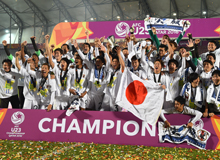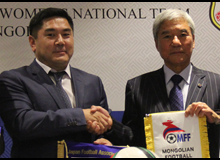As with most sudden success stories, Guam's performances in 2018 FIFA World Cup qualifying were built on years of difficult but necessary work done behind the scenes.
Victories over India and Turkmenistan, as well as a draw with Oman, showed the world Guam had come a long way since conceding 35 goals in two matches during 2002 World Cup qualifier. While their latest attempt ended after the second round, it also provided vindication for the Guam Football Association's plan of sticking to a long-term vision and making good use of available support.
Guam FA president Richard Lai, speaking at the 49th Executive Committee Meeting of the EAFF (East Asian Football Federation), said turning financial support into essential infrastructure provided the base for the country's ascent.
“Throughout the last 10 to 15 years, we received a lot of support from the Japan Football Association and Korean Football Association in terms of coaching support and financial support,” he said. “At the same time, we received support from the FIFA infrastructure like the Goal project. We finally realized that you don't need to compete on the world stage, but you get all those benefits by applying for grants from FIFA to build a football pitch or to build an office.
“With the infrastructure, we started building an institution. You must have a classroom for your student to go to class, but you can have the best classroom, the best infrastructure and a computer laboratory, but if you don't have an instructor, it won't work. For the past 15 years, we utilized the support from the EAFF, FIFA, and AFC to build an infrastructure, football pitch, office, lecture hall, classroom. Once I had those, Japan FA and Korea REP FA donated professional coaches to us to start grassroots football.”
Benefits from emphasizing grassroots football can take a decade or more to arrive, if they arrive at all, but in time it bore fruit for Guam. Starting small, Guam set an initial target of having their youth teams beat the likes of Macau, Mongolia, and Hong Kong. As those results began to come, confidence and interest in the team grew.
“15 years ago, we were the No. 7-played sport on the island; now we're the No. 1 sport,” Lai said. “Now we have children who were born in Guam and whose family lived in Guam but now live in different parts of the world sending us information about how old they are, what they are playing, and whether they can come back and represent Guam.”
Guam's efforts continue. Utilizing another FIFA grant, the FA is adding 2,000 seats to the National Training Center, increasing its capacity to 5,000. Lai said he expects every seat to be filled when the stadium hosts the first round of qualifying for the EAFF Women's East Asian Championship 2017.
Guam men’s squad for the first time will be starting the tournament from the second round which will take place in Chinese Taipei as their rise in FIFA ranking earned them seeded position.
“Football is almost like candy. Once you have a taste of the candy, you want more and more,” Lai said. “It's the same with our football association. Now we're in the 50th percentile of Asia, and we want to push for the top 20 percent, 10 percent. But of course, we need the support of the EAFF, FIFA, AFC, and also ourselves. The sky is the limit, so we will continue to push.”
EAST ASIAN FOOTBALL FEDERATION

COLUMN

Long-Range Vision and Smart Investment Paying Dividends for Rising Guam
+
10passion









